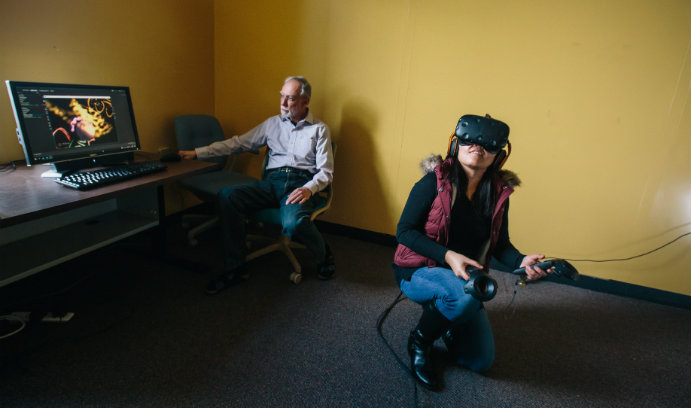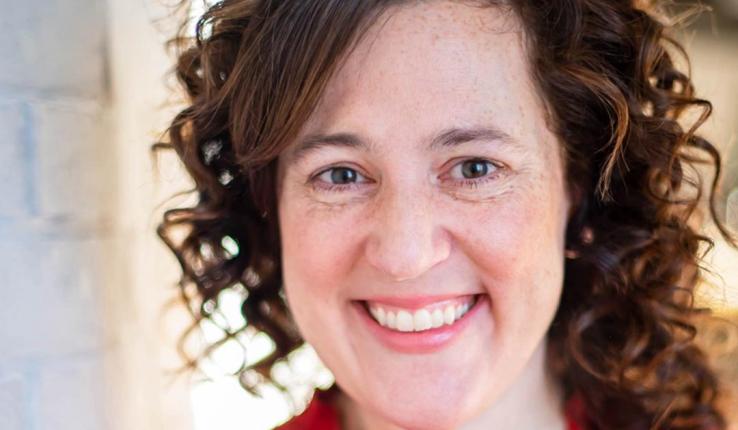Can Virtual Reality Improve Learning?

A proposed College of Education pilot study would examine whether virtual reality can enhance students’ writing fluency. Graduate student Yuanyuan Zhang dons the high-end HTC Vive virtual reality system while Scott Garrigan, professor of practice of teaching, learning and technology, views the video monitor. Photo by Christa Neu.
How can virtual reality experiences improve the writing fluency and academic achievement of special needs students?
Researchers in the College of Education will explore applications as part of a proposed pilot project involving elementary and secondary school children at Lehigh-governed Centennial School, which serves children with autism and behavioral challenges.
Scott Garrigan, professor of practice of teaching, learning and technology, will lead the study, which would expose students to virtual reality—on the bottom of the sea—and assess whether the experiences improve or transform their learning, including their writing and communication skills. Co-principal investigators will be Centennial lead teacher Sara Heintzelman and Centennial school psychologist Julie Fogt.
Lehigh’s Center for Innovation in Teaching and Learning purchased two high-end HTC Vive virtual reality systems, including one housed in a second-floor lab at the College of Education. Garrigan, who requested the purchase, will use the system in the proposed pilot project, but he also has been training students, faculty and community leaders in its use and testing its capabilities.
"This gives future educators and technology educators a window into what's coming,” he said. “It helps them think about the new technologies they see, it helps them think about how something can be learned differently if you're in it compared to if you’re reading about it or looking at it."
Ilena Key, assistant director of Library and Technology Services at Lehigh, said a second Vive system will be used to set up a Virtualization Sandbox on campus to allow for further exploration by students and faculty.
“Since [Thomas] Edison we’ve been looking at screens, we’ve been looking at information,” said Garrigan, in reference to inventions by Edison and his team in the area of motion pictures. “With this technology, you are immersed in it. You can’t overstate that change, that difference.
“It literally can create a virtual environment—virtual reality is its name—but in a way that you’re comfortable in it,” he said. “You feel like it’s real. You can work in it, and the ‘how we work in it’ is new. That’s still being developed. So this is the beginning of as big a change as Edison started with screens.”
To experience the virtual reality, participants don headsets and goggles, which allow them to look around—and move around in—the virtual spaces. They can travel to places they’ve possibly never been, pick up objects and immerse themselves in the middle of their own creations. Garrigan said virtual reality already is finding applications in surgical training and military training.
“This is an experience,” he said. “Love it, hate it, it is an experience.”
At the COE lab, participants can go under the sea to inspect a shipwreck and experience a whale swimming past them. Or, they can step inside a museum, where they can get a close up look at Leonardo da Vinci’s Mona Lisa or stand beside Terra Cotta Warriors from China. They can create colorful art all around themselves.
"Virtual reality is a very powerful educational system,” Garrigan said. “Just as we learn very rapidly through hands-on activities or watching someone do something in real life, those things can be modeled in VR in ways that are more powerful than reading about it or watching a film. It can be interactive."
Garrigan said two Centennial students have been among the more than 100 people who have already come to COE to experience virtual reality. While both students loved the experience, he said, one student who usually has trouble expressing himself was so engaged he wrote a rich, detailed description of what he saw.
“This is powerful stuff,” he said, then asked, “Does that work with every kid?”
The pilot study would begin to answer that question. As proposed, it would take students through two different experiences—four would view environments in virtual reality and four would view the environments on a video monitor. The students would then be asked to write about their experiences, with researchers assessing their writing for richness of detail, readability and, possibly, speed of writing and word count.
Garrigan, who studies as well as teaches educational technologies, is excited about the possibilities that virtual reality can create in the classroom.
“This is Thomas Edison’s flickering screen,” he said. “It’s just beginning, but it’s still powerful even in its beginning.”
Garrigan and several COE students plan to attend the Pennsylvania Educational Technology Conference in February to help introduce educational technology leaders to advanced virtual reality.
Posted on:




